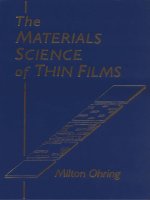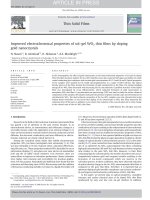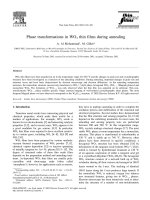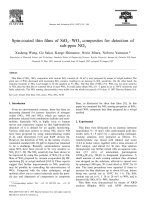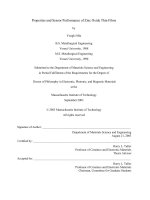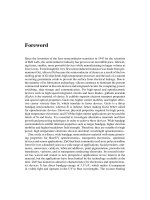sekkat, z. (2002). photoreactive organic thin films
Bạn đang xem bản rút gọn của tài liệu. Xem và tải ngay bản đầy đủ của tài liệu tại đây (36.46 MB, 582 trang )
PHOTOREACTIVE
ORGANIC
THIN FILMS
This page intentionally left blank
PMOTftRFAPTIVF
_- K
• ^^^
• ''V^V' »» • • • M ^
^ • •
^
I
I
W
^H
ORGANIC
TTLJI |L| C11 ' lUl O
I" "'PMfiM- '''| iLi'il'3
Edited by
Zouheir Sekkat
Osaka University, Japan
Wolfgang Knoll
Max-Planck Institut fur Polymerforschung,
Germany
/^ ACADEMIC PRESS
\^_^x An imprint of Elsevier Science
Amsterdam Boston London New York Oxford
San Francisco Singapore Sydney Tokyo
Paris
San Diego
This book is printed on acid-free paper. ©
Copyright © 2002, Elsevier Science (USA).
All rights reserved.
No part of this publication may be reproduced or transmitted in any form or by any
means, electronic or mechanical, including photocopy, recording, or any information
storage and retrieval system, without permission in writing from the Publisher.
Request for permission to make copies of any part of the work should be mailed to:
Permissions Department, Harcourt, Inc., 6277 Sea Harbor Drive, Orlando,
Florida 32887-6777.
Explicit permission from Academic Press is not required to reproduce a maximum of
two figures or tables from an Academic Press chapter in another scientific or research
publication provided that the material has not been credited to another source and that
full credit to the Academic Press chapter is given.
Academic Press
An imprint of Elsevier Science
525 B Street, Suite 1900, San Diego, California 92101-4495, USA
Academic Press
An imprint of Elsevier Science
84 Theobald's Road, London WC1X 8RR, UK
Library of Congress Catalog Card Number: 2002104260
International Standard Book Number: 0-12-635490-1
PRINTED IN THE UNITED STATES OF AMERICA
02 03 04 05 06 07 MB 9 8 7 6 5
4
3
2
1
••CONTENTS
CONTRIBUTORS xv
PREFACE xix
•
H PHOTOISOMERIZATIONANDPHOTO-ORIENTATIONOF
i
AZOBENZENES
I Photoisomerization of Benzenes
HERMANN RAU
1.1 Introduction 3
1.2 The Azo Group 5
1.2.1 Spectroscopic Properties 5
1.2.2 Isomerization 7
1.3 Azoaromatics of the Azobenzene Type 13
1.3.1 Spectroscopic Properties 14
1.3.2 Isomerization of Molecules of the Azobenzene Type 20
1.4 Azoaromatics of the Aminoazobenzene Type 25
1.4.1 Spectroscopic Properties 25
1.4.2 Isomerization of Molecules of the Aminoazobenzene Type
26
v
yj
CONTENTS
1.5 Azoaromatics of the Pseudo-Stilbene Type 27
1.5.1 Spectroscopic Properties 27
1.5.2 Isomerization of Molecules of the Pseudo-Stilbene Type
1.6 The Isomerization Mechanism 31
1.6.1 Azobenzene-Type Molecules 31
1.6.2 Pseudo-Stilbene-Type Molecules 37
1.7 Concluding Remarks 38
29
2 Ultrafast Dyamics in the Excited States of Azo Compounds
TAKAYOSHI KOBAYASHIANDTAKASHI SAITO
2.1 Introduction 50
2.2 Experimental Section 52
2.3 Results and Discussion 52
2.3.1 1PA2N 52
2.3.2 DMMAB 56
3 Photo-Orientation by Photoisomerization
ZOUHEIR SEKKAT
3.1 Introduction 64
3.2 Photoisomerization of Azobenzenes 65
3.3 Photo-Orientation by Photoisomerization 68
3.3.1 Base Ground Work 68
3.3.2 Theory of Photo-Orientation 69
3.4 Photo-Orientation of Azobenzenes: Individualizable Isomers 79
3.4.1 Reorientation within the trans—>cis Photoisomerization 79
3.4.2 Reorientation within the cis-*trans Thermal
Isomerization 83
3.5 Photo-Orientation of Azo Dyes: Spectrally Overlapping
Isomers 83
3.6 Photo-Orientation of Photochromic Spiropyrans and
Diarylethenes 87
3.6.1 Photoisomerization of Spiropyrans and Diarylethenes 88
3.6.2 Spectral Features of Photo-Orientations 89
3.6.3 Photo-Orientation Dynamics and Transitions Symmetry 89
3.7 Conclusion 96
APPENDIX 3A Quantum Yields Determination 98
APPENDIX 3B Demonstration of Equations 3.12 through 3.15 102
CONTENTS
yii
• • PHQTOISOMERIZATIQN IN ORGANIC THIN FILMS
!
4 Photoisomerization and Photo-Orientation of Azo Dye in Films
of Polymer: Molecular Interaction, Free Volume, and Polymer
Structural Effects
ZOUHEIR SEKKAT AND WOLFGANG KNOLL
4.1 Introduction 108
4.2 Photoisomerization of Azobenzenes in Molecularly Thin Self-Assembled
Monolayers: Photo-Orientation and Photo-Modulation of the Optical
Thickness 110
4.2.1 Pbotoisomerization of Azo-SAMs 110
4.2.2 Photo-Orientation in Molecularly Thin Layers (Smart
Monolayers) 111
4.2.3 Photo-Modulation of the Optical Thickness of Molecularly Thin
Layers 114
4.3 Photoisomerization and Photo-Orientation of Azobenzenes in
Supramolecular Assemblies: Photo-Control of the Structural and Optical
Properties of Langmuir-Blodgett-Kuhn Multilayers of Hairy-Rod
Azo-Polyglutamates 117
4.4 Polymer Structural Effects on Photo-Orientation 122
4.4.1 Photoisomerization and Photo-Orientation of High-Temperature
Azo-Polyimides 123
4.4.2 Photoisomerization and Photo-Orientation of the Flexible
Azo-Polyur ethanes 128
4.5 Pressure Effects on Photoisomerization and Photo-Orientation 134
4.6 Conclusion 140
5 Chiral Polymers with Photoaffected Phase Behavior for Optical
Data Storage
MIKHAILV. KOZLOVSKY, LEV M. BLINOV, AND W. HAASE
5.1 Introduction 145
5.2 Amorphous, Optically Isotropic Mesophase of Chiral Side-Chain
Polymers with a Hidden Layer Structure—The "Isotropic Smectic"
Phase 148
5.3 Photoinduced Birefringence in Photochromic IsoSm*
Copolymers 152
5.4 Holographic Grating Recording 160
5.5 Photoinduced Alignment of Low Molar Mass Liquid Crystals 166
5.6 Photoaffected Phase Behavior and the LCPT Photorecording 168
5.7 Conclusions 172
vj|j
CONTENTS
6 Photoisomerization in Langmuir-Blodgett-Kuhn Structures
HENNING MENZEL
6.1 Introduction 179
6.2 Other Dyes Used in Photoactive LBK Films 180
6.2.1 Stilbenes 180
6.2.2 Salicylidene Aniline 181
6.23 Spiropyrans 182
6.2.4 Other Chromophores 182
6.3 UV-Vis Spectroscopy as an Analytical Tool for the Investigation of
Azobenzene LBK Film Structure 183
6.3.1 Trans-Cis Interconversion 183
6.3.2 Aggregation 184
6.4 Examples of the Influence of Structure on Photoisomerization 186
6.4.1 Mixing with Other Amphiphiles 188
6.4.2 Adjusting the Structure of the Azobenzene Amphiphile 189
6.4.3 Coupling of Azobenzene Moities to Polymers 191
6.5 Examples of the Manipulation of LBK Film Structure by
Photoisomerization 201
6.5.1 Structure Change 201
6.5.2 Photoreorientation 208
6.6 Examples of LBK Films with a Structure Tailored for the Desired
Application 210
6.7 Summary 212
7 Electronic and Optical Transduction of Photoisomerization
Processes at Molecular- and Bimoleculan-Functionalized
Surfaces
EUGENII KATZ, ANDREW N.SHIPWAY, AND ITAMARWILLNER
7.1 Introduction 220
7.2 Electronically Transduced Photochemical Switching of Organic
Monolayers and Thin Films 221
7.3 Electronically Transduced Photochemical Switching of Enzyme
Monolayers 227
7.3.1 Redox-Enzymes Tethered with Photoisomerizable Groups
7.3.2 Enzymes Reconstituted onto Photoisomerizable
FAD-Cofactors
230
7.4 Transduction at "Command" Interfaces 232
7.4.1 Electrochemical Processes of Organic Redox Molecules at
"Command" Interfaces 233
7.4.2 Electrochemical Processes of Proteins and Enzymes at
"Command" Interfaces 238
7.4.3 Surface-Reconstituted Enzymes at Photoisomerizable
Interfaces
243
7.4.4 Mechanical Photoisomerizable Monolayers 243
228
CONTENTS
Jx
7.5 Recognition Phenomena at Surfaces Using Photoisomerizable Guest or
Host Components 246
7.5.1 Affinity Interactions at Interfaces Using Soluble
Photoisomerizable Guest Components 246
7.5.2 Affinity Interactions at Interfaces Using Immobilized
Photoisomerizable Host Components 249
7.5.3 Reversible Bioaffinity Interactions at Photoisomerizable
Interfaces
249
7.5.4 Complex Photochemical Biomolecular Switches 256
7.6 Interlocked Compounds as Mechanical Components at
Photoisomerizable Interfaces 258
7.7 Conclusions 258
H M PHOTOCHEMISTRY AND ORGANIC NONLINEAR
I
OPTICS
8 Photoisomerization Effects in Organic Nonlinear Optics:
Photo-Assisted Poling and Depoling and Polarizability
Switching
ZOUHEIR SEKKAT
8.1
8.2
8.3
8.4
8.5
Introduction 272
Photo-Assisted Poling 272
Photo-Induced Depoling 278
Polarizability Switching by Photoisomerization 280
Conclusion 283
APPENDIX 8A From Molecular to Macroscopic Nonlinear Optical
Properties 284
9 Photoisomerization in Polymer Films in the Presence of
Electrostatic and Optical Fields
ANDRE KNOESEN
9.1
9.2
9.3
9.4
9.5
Introduction 289
Photoisomerization and Nonlinear Polarizability 289
Alignment of Isomers in Polymers with Electric Fields 293
Second Harmonic In-situ Investigation of Photoisomerization
Conclusion 303
297
CONTENTS
10 Photoassisted Poling and Photoswitching of NLO Properties of
Spiropyrans and Other Photochromic Molecules in Polymers
and Crystals
JACQUES A. DELAIRE, ELENA ISHOW, AND KEITARO NAKATANI
10.1 Introduction 306
10.2 Molecular Second-Order Nonlinear Optical Polarizabilities of
Photochromic Molecules 307
20.2.1 Definitions 307
10.2.2 Methods of Determining Molecular Hyperpolarizabiliti.es:
Experiments and Calculations 308
10.2.3 Influence of Photochromism on Molecular
Hyperpolarizabilities 311
10.3 Photoassisted Poling of Photochromes Other Than Azo Derivatives in
Polymers 315
103.1 Principle 315
10.3.2 Measurement Techniques 317
10.3.3 Examples 318
10.3.4 Applications 320
10.4 Photoswitching of NLO Properties in Organized Systems and
Materials 321
10.4.1 Introduction 321
10.4.2 Photoswitching in Polymers 321
10.4.3 Photoswitching of NLO Properties of Noncentrosymmetric
Photochromic Crystals 322
10.4.4 Potential Applications 324
10.5 Conclusion 326
11 All Optical Poling in Polymers and Applications
ALEKSANDRAAPOSTOLUK, CELINE FIORINI-DEBUISSCHERT, AND
JEAN-MICHEL NUNZI
11.1 Standard Poling Techniques 332
11.1.1 Electric Field Poling (Corona Poling) 332
11.1.2 Photo-Assisted Electric Field Poling 333
11.2 All Optical Poling 334
11.2.1 Quasi-Permanent AII Optical Encoding of
Noncentrosymmetry 33 7
11.2.2 Relevant Parameters for an Efficient All Optical
Poling 340
11.2.3 Characterization of the Photoinduced %*2) Susceptibility
11.2.4 Optimization of the Poling Efficiency
353
11.2.5 Perspectives 360
347
CONTENTS
xj
12 Photoinduced Third-Order Nonlinear Optical Phenomena in
Azo-Dye Polymers
VICTOR M.CHURIKOVAND CHIA-CHEN HSU
12.1 Introduction 366
12.2. Third Harmonic Generation 367
12.2.1 Theoretical Model 367
12.2.2 Experiment 373
12.2.3 Results 375
12.3 Electric Field Induced Second Harmonic Generation
12.3.1 Theory 381
12.3.2 Experiment 383
12.3.3 Results and Discussion 384
12.4 Degenerate Four-Wave Mixing 388
12.4.1 Introduction 388
12.4.2 Experiment 389
12.4.3 Experimental Results and Discussion 391
12.5 Prospective and Conclusions 392
381
•ffl OPTICAL MANIPULATION AND MEMORY
13 Photoinduced Notions in Azobenzene-Based Polymers
ALMERIA NATANSOHN AND PAUL ROCHON
13.1 Introduction 400
13.2 Photoinduced Motions 400
13.2.1 Photoinduced Motions at the Molecular Level 402
13.2.2 Photoinduced Motions at the Domain Level 411
13.2.3 Photoinduced Motions at the Macroscopic Level 417
13.3 Possible Photonic Devices 420
13.3.1 Reversible Optical Storage 420
13.3.2 Holographic Storage 421
13.3.3 Waveguides 421
13.3.4 Couplers 421
13.3.5 Wavelength and Angle Filters 422
13.3.6 Polarization Separators 422
13.3.7 Optoelectronic Switches 422
13.3.8 Liquid Crystal Orientation 423
13.3.9 Optical Switches 423
13.4 Conclusions 423
xjj
CONTENTS
14 Surface-Relief Gratings on Azobenzene-Containing Films
OSVALDO N.OLIVEIRA,JR.,LIAN LIJAYANT KUMAR, AND SUKANT K.TRIPATHY
14.1 Introduction 430
14.2 Processes of SRG Formation 432
14.2.1 Light-Driven Mass Transport 436
14.2.2 Ablation, Photobleaching, and Photodegradation 440
14.2.3 SRGs on LC Polymers 443
14.3 Theoretical Models 446
14.3.1 Free Volume Model 446
14.3.2 Field-Gradient Force Model 446
14.3.3 Mean-Field Theory Model 448
14.3.4 Model of Viscous Mass Flow 451
14.3.5 Diffusion Model 452
14.3.6 Model Using Jones Matrix Formalism 453
14.3.7 Comments on the Models 453
14.4 Factors Influencing the Formation of SRGs 454
14.4.1 Plasticization 454
14.4.2 Importance of the Dye and Degree of
Azofunctionalization 455
14.4.3 Polarization Dependence 456
14.4.4 Dependence on the Molecular Weight 458
14.4.5 SRG Inscription Requiring Thermal Treatment 459
14.4.6 Single-Beam Experiments 460
14.4.7 Dependence on the Beam Intensity 461
14.4.8 Main Chain and Conjugated Azopolymers 463
14.4.9 Film Architecture—SRGs Recorded on Organized Films and
Gels 464
14.4.10 Post-writing Evolution and Erasure Characteristics 468
14.5 Open Questions and Challenges for the Near Future 472
14.6 Possible Applications 473
14.6.1 Holography Applications 4 74
14.6.2 Liquid Crystal Anchoring 475
14.6.3 Waveguide Couplers 476
14.6.4 Intricate Surface Structures 477
14.6.5 Electro-Optic Devices and Second Harmonic
Generation 479
14.7 Final Remarks 480
15 Dynamic Photocontrols of Molecular Organization and Motion
of Materials by Two-Dimensionally Arranged Azobenzene
Assemblies
TAKAHIRO SEKI AND KUNIHIRO ICHIMURA
15.1 Introduction
487
CONTENTS
xifi
15.2 Photocontrol of Liquid Motion by Azobenzene Monolayers 489
15.2.1 Molecular Design and Preparation of Azobenzene
Monolayers 490
15.2.2 Spreading/Retraction Motion of Liquid Droplets 491
15.2.3 Displacement of Liquids 492
15.2.4 Outlook 495
15.3 Photocontrol of Polymer Chain Organizations 495
15.3.1 Polydiacetylene 495
15.3.2 Polysilane 497
15.4 Photoinduced Motions and Mass Migrations 500
15.4.1 Photomechanical Effects in Azobenzene Polymer
Monolayers 500
15.4.2 Large Mass Migration 505
15.5 Concluding Remarks 508
16 3D Data Storage and Near-Field Recording
YOSHIMASA KAWATAAND SATOSHI KAWATA
16.1 Introduction 514
16.2 Bit-Oriented 3D Memory 514
16.3 Photochromic Materials for 3D Optical Memory 516
16.3.1 Spirobenzopyran Derivatives 516
16.3.2 Diarylethene Derivatives 519
16.3.3 Azobenzene Derivatives 520
16.4 Recording and Readout Optics 523
16.4.1 Single-Photon Recording 523
16.4.2 Single-Beam, Two-Photon Recording 524
16.4.3 Right-Angle, Two Beams, Two-Photon Recording 524
16.4.4 Reflection Confocal Reading 525
16.4.5 Reflection Confocal Reading with Multilayered Medium
16.4.6 Confocal Phase-Contrast Microscope 529
16.4.7 Polarization Reading 530
16.4.8 Differential Phase-Contrast Microscope with a Split
Detector 533
16.5 Near-Field Recording 533
16.5.1 Azobenzene Derivatives for Near-Field Recording 533
16.5.2 Application of Near-Field Recording to High-Resolution
Imaging 535
16.6 Concluding Remarks 537
17 Synthesis and Applications of Amorphous Diarylethenes
TSUYOSHI KAWAIAND MASAHIRO IRIE
17,1 Quasi-Stable Amorphous Diarylethenes
542
527
x jy
CONTENTS
17.2
17.3
17.4
17.5
Thermally Stable Amorphous Diarylethenes 543
Optical Properties of Amorphous Diarylethenes 545
Charge Transport in Amorphous Diarylethene Films 549
Summary 551
INDEX 553
••CONTRIBUTORS
Numbers in parentheses indicate the pages on which the authors' contributions begin.
Aleksandra Apostoluk (331) Universite d' Angers, Laboratoire POM A,
UMR-CNRS 6136, ERT Cellules Solaires Photo Volataiques Plastiques, 2,
Boulevard Lavoisier 49045 Angers Cedex 01 France
Lev M. Blinov (145) Institute of Crystallography, Russian Academy of
Sciences 117333, Moscow, Russia
Victor M. Churikov (365) Department of Physics National Chung Cheng
University, Ming Hsiung, Chia Yi 621, Taiwan, ROC
Jacques A. Delaire (305) PPSM, CNRS UMR 8531, Ecole Normale Superieure
de Cachan, 61 , avenue du President Wilson, 94235 Cachan Cedex, France
Celine Fiorini-Debuisschert (331) CEA Saclay, DRT-LIST-DECS-SE2M,
Laboratoire Composants Organiques, 91191 Gif sur Yvette Cedex, France
Wolfgang Haase (145) Institute of Physical Chemistry, Darmstadt University
of Technology, D-64287, Darmstadt, Germany
Chia-Chen Hsu (365) Department of Physics National Chung Cheng
University, Ming Hsiung, Chia Yi 621, Taiwan, ROC
Kunihiro Ichimura (487) Research Institute for Science and Technology,
Science University of Tokyo, 2641 Yamazaki, Noda, Chiba 278-8510,
Japan
xv
jjyj
CONTRIBUTORS
Masahiro Me (541) CREST, Japan Science and Technology Corporation, JST,
Hakozaki 6-10-1, Higashi-ku, Fukuoka 812-8581, Japan
Elena Ishow (305) PPSM, CNRS UMR 8531, Ecole Normale Superieure de
Cachan, 61 , avenue du President Wilson, 94235 Cachan Cedex, France
Eugenii Katz (219) Institute of Chemistry and the Farkas Center for LightInduced Processes, Hebrew University of Jerusalem, Jerusalem 91904,
Israel
Yoshimasa Kawata (513) Shizuoka University, Department of Mechanical
Engineering, Johoku, Hamamatsu 432-8561, Japan
Satoshi Kawata (513) Department of Applied Physics, Osaka University,
Suita, Osaka 565-0871, Japan
Tsuyoshi Kawai (541) Department of Applied Chemistry; Graduate School of
Engineering, Kyushu University, Hakozaki 6-10-1, Higashi-ku, Fukuoka
812-8581, Japan
Andre Knoesen (289) Department of Electrical and Computer Engineering,
University of California Davis, Davis, CA 95616-5294, USA
Wolfgang Knoll (107) Max-Planck Institut fur Polymerforschung,
Ackermannweg 10, 55128 Mainz, Germany
Takayoshi Kobayashi (49) Department of Physics, University of Tokyo,
Hongo 7-3-1, Bunkyo-ku, Tokyo 113-0033, Japan
Mikhail V. Kozlovsky (145) Institute of Physical Chemistry, Darmstadt
University of Technology, D-64287, Darmstadt, Germany
Jayant Kumar (429) Center for Advanced Materials, University of
Massachusetts Lowell, 1 University Avenue, Lowell, MA 01854, USA
Lian Li (429) Center for Advanced Materials, University of Massachusetts
Lowell, 1 University Avenue, Lowell, MA 01854, USA
Henning Menzel (179) Institut fur Technische Chemie, Technische Universitat
Braunschweig, D-38106 Braunschweig, Germany
Keitaro Nakatani (305) PPSM, CNRS UMR 8531, Ecole Normale Superieure
de Cachan, 61 , avenue du President Wilson, 94235 Cachan Cedex, France
Almeria Natansohn (399) Department of Chemistry, Queen's University,
Kingston, ON K7L 3N6, Canada
Jean-Michel Nunzi (331) Universite d'Angers, Laboratoire POM A, UMRCNRS 6136, ERT Cellules Solaires PhotoVolatai ques Plastiques, 2,
Boulevard Lavoisier 49045 Angers Cedex 01, France
Osvaldo N. Oliveira, Jr. (429) Institute de Fisica de Sao Carlos, USP, CP 369,
13560-970 Sao Carlos, SP, Brazil
Hermann Rau (3) Institut fur Chemie, Universitat Hohenheim, D-70593
Stuttgart, Germany
Paul Rochon (399) Department of Physics, Royal Military College, Kingston,
ON K7K 5LO, Canada
Takashi Saito (49) Department of Physics, University of Tokyo, Hongo 7-3-1,
Bunkyo-ku Tokyo 113-0033, Japan
CONTRIBUTORS
x ¥ jj
Takahiro Seki (487) Chemical Resources Laboratory, Tokyo Institute of
Technology, 4259 Nagatsuta, Midori-ku, Yokohama 226-8503, Japan
Zouheir Sekkat (63, 107, 271) Department of Applied Physics, Osaka
University, Suita, Osaka 565-0871, Japan
Andrew N. Shipway (219) Institute of Chemistry and the Farkas Center for
Light-Induced Processes, Hebrew University of Jerusalem, Jerusalem
91904, Israel
Sukant K. Tripathy (429) Center for Advanced Materials, University of
Massachusetts Lowell, 1 University Avenue, Lowell, MA 01854, USA
Itamar Willner (219) Institute of Chemistry and the Farkas Center for LightInduced Processes, Hebrew University of Jerusalem, Jerusalem 91904,
Israel
This page intentionally left blank
i PREFACE
»
Research on optically sensitive chromophores containing polymeric films
(photoreactive organic thin films, POTF) has exploded during the past decade,
and it is continuing to be a very active area of science. Several important
phenomena have been discovered, especially at the contact of photochemistry
(photoisomerization) and nonlinear optics by the photoisomerization of nonlinear optical molecules in polymers. The material published in the book
covers photoreactivity in organic films from the most elementary to the most
sophisticated backgrounds, and discusses possible technological uses in views
of applications for fast electro-optic modulation, optical data storage, and
holography. This book is a comprehensive volume that encompasses the
known knowledge on POTF research and applications.
POTF have been investigated intensively in the past few years due to
requirements in the areas of optoelectronics and photonics; and linear and
nonlinear optical (NLO) effects induced by photo-orientation of photoisomerizabie NLO chromophores in polymers have attracted much attention.
Light can manipulate the chromophores' orientation by photoisomerization
via polarized transitions such that centrosymmetry and isotropy are
alleviated, and anisotropy and quadratic and cubic optical nonlinearities are
induced. Optical poling techniques, e.g. induced molecular polar orientation,
which result in second order NLO effects have been reported, and the
coupling between photochemistry and organic nonlinear optics has emerged
as a new discipline in the past decade. Surface relief gratings created by
xix
xx
PREFACE
photo-induced mass movement of polymers have also been reported.
Inasmuch as optical ordering of photoisomerizable molecules is being intensively studied, its theoretical quantification helps bridge independent studies
in the areas of nonlinear optics and photochemistry.
Photoisomerization was studied from a purely photochemical point of
view in which photo-orientation effects can be disregarded. While this feature
can be true in low viscosity solutions where photo-induced molecular orientation can be overcome by molecular rotational diffusion, in polymeric environments, especially in thin solid film configurations, spontaneous molecular
mobility can be strongly hindered and photo-orientation effects are appreciable. The theory that coupled photoisomerization and photo-orientation
processes was also recently developed, based on the formalism of Legendre
Polynomials, and more recent further theoretical developments have helped
quantify coupled photoisomerization and photo-orientation processes in films
of polymer.
A number of polymers containing photoisomerizable chrornophores have
been reported, and several authors reported studies in Langmuir-BlodgettKuhn azo-polymers as multilayer structures and alignment layers for liquid
crystal molecules, self-assembled monolayers, amorphous and liquid crystalline polymers and so on. In recent years, studies of the role of interchromophore interactions and molecular addressing have been reported, and
questions have begun to arise concerning the relationship of optical ordering
processes in amorphous polymers to the Tg and polymer structure, including
the main chain rigidity, the free volume, and the nature of the connection of
the chromophore to a rigid or a flexible main-chain. These studies correlated
the optical ordering (nonpolar and polar) to the polymer structure in a series
of very high Tg (up to 350 °C) rigid or semirigid NLO polymers, and demonstrated a new way of probing sub-Tg polymer dynamics in photoreactive
NLO polymers.
These intensive studies on POTF have been performed by a large number
of scientists from a variety of communities, including polymer scientists,
photochemists and photophysicists, chemists and chemical engineers, optical
physicists and optical engineers, and researchers in the field of organic nonlinear optics. Each of these scientists approached POTF research from the
point of view of his or her own field. This book unifies the various subthemes of photoisomerization research and bridges different disciplines.
Leading experts have encapsulated their work on POTF research in comprehensive and self-consistent chapters. Both fundamental and application issues
are discussed; and the readers, including non-specialists, can not only appreciate that this book represents the largest collection of information on this
topic published in a single book, but also see and eventually acknowledge the
interdisciplinary nature of POTF research and applications. We expect this
book to be the essential reference on POTF science for both students and for
researchers in adjacent fields.
Zouheir Sekkat
Wolfgang Knoll
PHOTOISMOMERIZATION
AND PHOTOORIENTATION OF
AZOBENZENES
This page intentionally left blank
I
PHOTOtSOM€RIZATION OF
AZOBENZENES
HERMANN RAU
Institut fiir Chemie, Universitdt Hohenheim, D-70593 Stuttgart, Germany
1 . 1 INTRODUCTION
1.2 THE AZO GROUP
1.2.1 Spectroscopic Properties
1.2.2 Isomerization
1.3 AZOAROMATICS OFTHEAZOBENZENETYPE
1.3.1 Spectroscopic Properties
1.3.2 Isomerization of Molecules of the Azobenzene Type
1.4 AZOAROMATICS OF THE AMINOAZOBENZENE TYPE
1.4.1 Spectroscopic Properties
1.4.2 Isomerization of Molecules of the Aminoazobenzene Type
1.5 AZOAROMATICS OF THE PSEUDO-STILBENETYPE
1.5.1 Spectroscopic Properties
1.5.2 Isomerization of Molecules of the Pseudo-StilbeneType
1.6 THE ISOMERIZATION MECHANISM
1.6.1 Azobenzene-Type Molecules
1.6.2 Pseudo-Stilbene-Type Molecules
1.7 CONCLUDING REMARKS
I.I
INTRODUCTION
Most of the phenomena described in this monograph on photoreactive organic thin films are based on the isomerization of units deliberately built into
molecules, molecular assemblies, or polymers. Most especially, the Spectroscopic and isomerization behavior of these units determines the switching and
triggering properties of the photoreactive systems and devices. Information
storage and nonlinear optical properties, as well as photo-control of equilibria
and of polymer, membrane, and other properties are exploited in applications.
The majority of the systems outlined in this monograph contain the
azobenzene moiety as the photoswitchable unit. Therefore, the first chapter
of this monograph deals with the properties of this simple molecule and its
simple derivatives. Applications for various purposes are covered in some of
the following chapters.
Azobenzene 1 (Figure 1.1A) is particularly useful for these applications
for the following reasons:
Photoreactwe Organic Thin films
Copyright 2002, Elsevier Science (USA). All rights of reproduction in any form reserved.
HERMANN RAU
1. The azobenzene unit is chemically stable at moderate temperatures
and against UV/VIS radiation;
2. On E-Z (trans-cis) conversion,1 it changes its absorption spectrum
considerably (Figure LIB);
3. On E-Z conversion, it changes its molecular shape, reducing the
distance between the p-positions from 1.0 to 0.59 nm (Figure 1.1A)
and increasing the dipole moment from 0 to ca. 3 Debye;2
4. Donor/acceptor substituted azobenzenes, which have large secondand third-order nonlinear optical properties, show a fast thermal Z-E
(cis-trans) conversion.
Items 2 to 4 warrant this chapter on photo-induced and thermal E-Z isomerization of the parent molecules, which are incorporated in numerous
macromolecular and supramolecular assemblies as the photo-active element.
Azo compounds are systematically addressed as "diazenes." This has to
be borne in mind when one conducts a literature research. The azo (diazene)
group is isosteric with the ethene group; stilbene and azobenzene have many
related features, but they also possess relevant different properties that make
azobenzenes superior for use as photo-switches.
To understand the photoresponsive properties of azobenzene and its
molecular family, it is necessary to discuss their spectroscopy and the mechanistic options of isomerization. A review of the spectroscopic properties of
azo compounds appeared in 1973.3 The isomerization properties of azobenzene were reviewed for several periods. Wyman4 covered the literature up to
1954, Ross and Blanc5 up to 1969, and Rau6'7 up to 1988. The present standalone review is restricted to the spectroscopy and isomerization of simple aromatic azo compounds. It is meant to serve as a basis for the detailed
treatments of complex photoresponsive systems in the following chapters of
this monograph.
The spectroscopic and photochemical, especially isomerization, features
of the azoaromatics warrant separation into three classes according to the
relative energy of the lowest lying I(n9n*) and l(n,n*) states: the azobenzene
type, the aminoazobenzene type, and the pseudo-stilbene type.6 This determines the structure of this chapter. Section 1.2 provides basic information on
(A)
200
E -azobenzene
Z-azobenzene
240
29P
320
360
400 440
400
S»
x/nm
FtCHIRE I.I (A) The E/Z isomerization system of azobenzene. (B) Absorption spectra of E- and Zazobenzene in EtOH solution.
